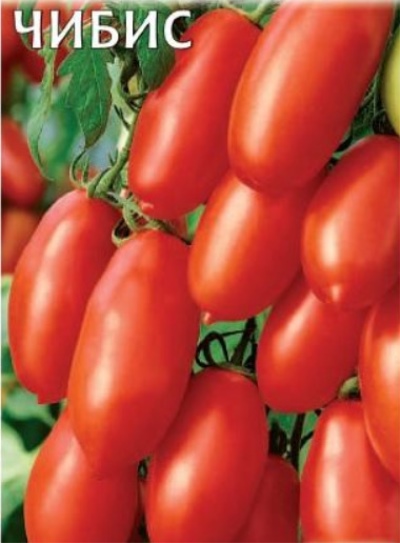
- Authors: V. I. Kozak
- Year of approval: 2007
- Category: grade
- Growth type: determinant
- Appointment: fresh consumption, for whole fruit preservation
- Ripening period: mid-early
- Ripening time, days: 105-110
- Growing conditions: for open ground, for film greenhouses
- Marketability: high
- Transportability: excellent
Chibis tomato can hardly be called a completely new plant. But this variety cannot be called old either. It is necessary to thoroughly understand this culture, and draw the correct conclusion.
Breeding history
The developer of Chibis is the breeder V.I. Kozak. The plant was allowed to grow in private gardens in 2007. Therefore, considerable experience has already been accumulated in dealing with it.
Description of the variety
This is precisely a variety, not a hybrid, and, moreover, having a determinant dynamics of development. It can be grown both in open ground and in greenhouses under a film. Lapwing bushes rise to a maximum of 0.5-0.7 m. They are covered with medium-sized foliage that has a simple green color.
The main qualities of the fruit
There is nothing unexpected here. The berries that have just appeared on this plant will be green. As they mature further, they will turn red. The mass of even adult fruits is about 55 g. They will form on simple inflorescences, on articulated stalks; always note the increased keeping quality of the crop.
Taste characteristics
Chibis is characterized by a high density of pulp.
Ripening and fruiting
This variety belongs to the mid-early group. Usually, the ripeness of the crop is reached 105-110 days after hatching of early shoots. The predominant harvest period is July. Of course, the weather can make significant adjustments to this schedule.
Yield
The collection reaches 3 kg from 1 plant. According to other information, the yield is 2.1 kg per 1 m2. Therefore, this variety is considered a fruitful plant. What is nice, the harvested berries are easy to transport.
The timing of planting seedlings and planting in the ground
It is necessary to sow containers with seeds at the end of March or in the first decade of April. Usually, readiness for transplanting seedlings is achieved in late spring or in the first decade of the calendar summer.

Growing tomato seedlings is an extremely important process, because it largely depends on whether the gardener will be able to harvest at all. All aspects must be taken into account, from seedbed preparation to planting in the ground.
Landing scheme
The optimal planting system, according to the seed suppliers, is 400x600 mm. For 1 sq. m can accommodate up to 6 bushes. But this opportunity should not be abused.

Growing and care
Elimination of stepchildren, unless the plant is excessively covered with them, will not be required. The picking of seedlings is carried out when the first true leaf is formed. Normal fruiting is possible without a garter. Lapwings are excellent for both gardening and plantation farming. Maintaining the declared yield is possible subject to the ripening of the berries removed in the blanche state.
Seedling care is quite common. We'll have to dive, water it. Top dressing is applied according to the standard schedule for tomatoes.Seedlings must be hardened before being transferred to a permanent growing site. Watering the bushes on the ridges should be abundant once every 7 days.
However, if it rains, watering should be less intensive. It is necessary to loosen the earth 1 time in 10-14 days. With the same frequency, the culture should be fed with complex compounds. With the simplest care, a large number of fruits can be harvested. Growing slightly larger berries is possible subject to the garter and timely formation.
For highest productivity, remove any stepchildren below the first brush. It is undesirable to touch all the others. After partial pinching, you will definitely need a support. A ripe crop can hang for a long time without cracking. The rapid development of the plant eliminates the danger of late blight, but the prevention of ailments through treatment with unsaturated potassium permanganate is quite possible.
Seeds are also disinfected with potassium permanganate before planting. The next step will necessarily be rinsing under running water. Hydrogen peroxide can be used instead of permanganate. It is also advised to process the planting material with growth activators. There are no more special "tricks".




A plant needs different micronutrients at each stage of growth. All fertilizers can be divided into two groups: mineral and organic. Folk remedies are often used: iodine, yeast, bird droppings, eggshells.
It is important to observe the rate and period of feeding. This also applies to folk remedies and organic fertilizers.
Disease and pest resistance
Top rot and cracking of fruits practically do not affect Chibis tomatoes. Other infections can be potentially dangerous. Prevention measures are already well developed, and do not differ from caring for other varieties.


Growing regions
You can plant a Chibis tomato and achieve a good result in:
Western Siberia;
Volga region;
areas of the North Caucasus and the Far East;
the European part of Russia.
Review overview
The gardeners' assessments note:
long storage of this variety;
small height of the bushes;
pleasant taste;
unsuitability for canning in cans;
a positive impression already at the first landing.

























































































